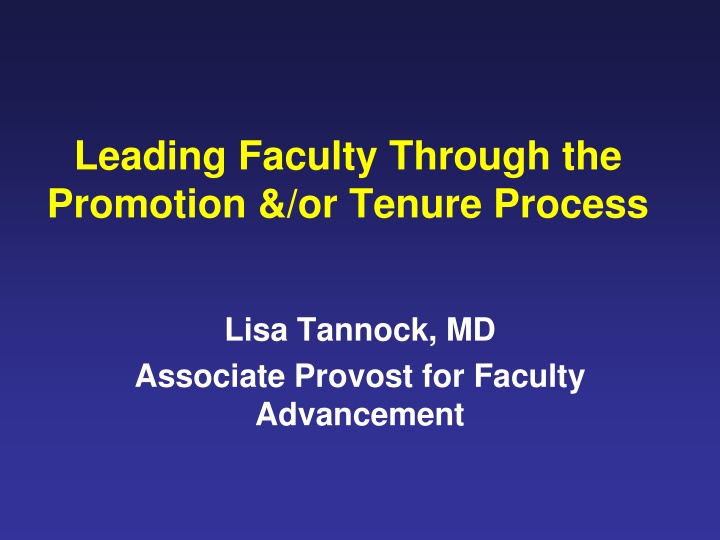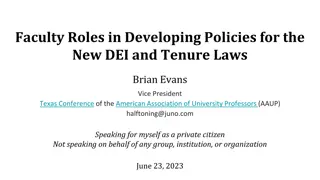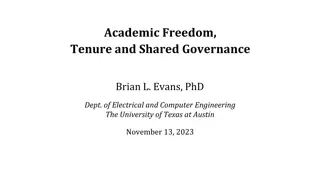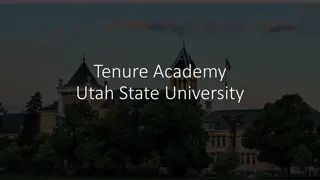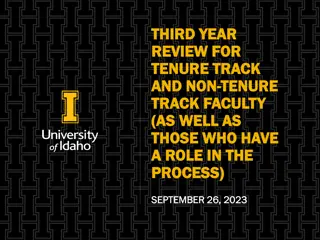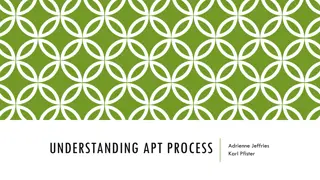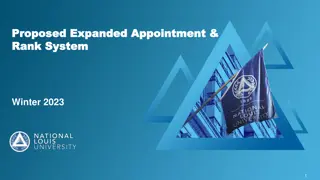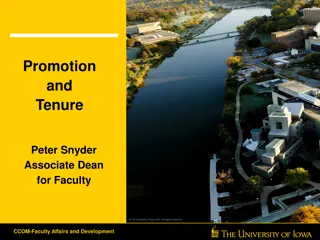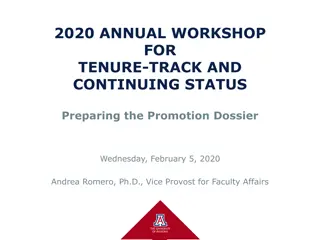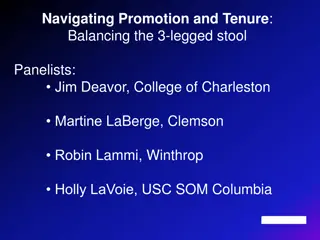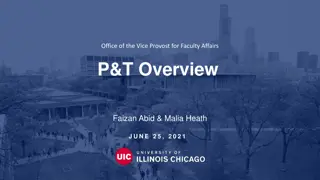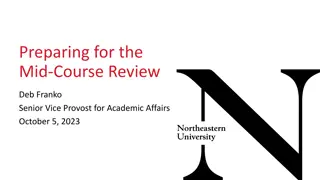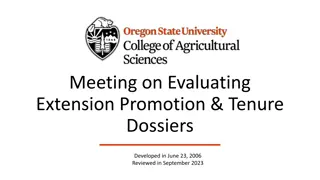Faculty Advancement Strategies: Leading Through Promotion & Tenure
Strategically guide faculty through the promotion and tenure process, emphasizing clear expectations, regular reviews, and building regional to national reputations. Avoid common pitfalls and support faculty success with targeted mentorship and recognition opportunities.
Download Presentation

Please find below an Image/Link to download the presentation.
The content on the website is provided AS IS for your information and personal use only. It may not be sold, licensed, or shared on other websites without obtaining consent from the author.If you encounter any issues during the download, it is possible that the publisher has removed the file from their server.
You are allowed to download the files provided on this website for personal or commercial use, subject to the condition that they are used lawfully. All files are the property of their respective owners.
The content on the website is provided AS IS for your information and personal use only. It may not be sold, licensed, or shared on other websites without obtaining consent from the author.
E N D
Presentation Transcript
Leading Faculty Through the Promotion &/or Tenure Process Lisa Tannock, MD Associate Provost for Faculty Advancement
Chairs Responsibilities for APT Keep faculty on track for promotion Review statement of evidences and ensure faculty meets these Guide faculty through their part in dossier preparation
Chair/ Director Responsibilities Keep faculty on track This starts in their first year 2 and 4 year reviews Encourage clock extensions if eligible Ensure expectations are clear Watch for (unintentional) mis-mentoring Watch for undocumented unit culture expectations Hold faculty accountable
Unit Statements of Evidence You should be the expert on unit s SOE Update as needed Ensure clarity Review them with faculty regularly
2 and 4 year Reviews Mandatory for tenure track, optional for other title series, associate professors Distinct from performance evaluation: should specifically address progress towards promotion OFA is building an automatic notification system Review and implement an action plan for faculty not making progress
What is needed for successful promotion? For Associate Prof: Regional reputation For Prof: National to International reputation* For both: meeting department statements of evidence for your department s SOE, weighted by faculty s DOE For CTS AR 2.6 says regional, and perhaps national reputation
Common Pitfalls Unintentional mis-mentoring of faculty Balance in productivity/performance discrepant to DOE Undocumented department culture and expectations Lukewarm external letters
How to Demonstrate Regional to National Reputation Giving talks Serving on state or national society committees Publishing Presenting at national meetings * For CTS faculty in COM, outside department meets regional needs Nominate your faculty for these activities! Sponsor them!
Timing In general, anything less than 5-6 years in rank is generally early If going up early both FACULTY and CHAIR need to address why Ideally, departmental and external letters will also explicitly address timing Don t go up early unless they exceed the requirements
Timing: what counts Time in academic positions (here, or elsewhere) Time since first faculty appointment or last promotion Fellowships don t count as time in academic rank Non-academic experience generally doesn t count
Sustained Trajectory Their CV and dossier need to demonstrate sustained activity, not just one year s worth
Dossier Prep Chief/Chair (admin) responsibility Provision of data to meet the statements of evidence Provide annual evaluations/ reviews Obtain external and internal letters Chair s letter Candidate s responsibility CV Teaching portfolio Personal statements on service, teaching, research Supporting documentation Review your department s criteria for promotion, and ensure that the dossier contains the needed items
Dossier Preparation Steps Faculty candidate prepares CV, personal statements, collects evidence Job description, DOE, performance evals, student letters Dossier sent out for external review Department faculty review entire dossier including external letters Chair s letter summarizes entire package
Chairs Responsibilities for APT Outside letters: 6 4 need to be suggested by chair/chief 2 suggested by faculty candidate All 6 are arm s length This can be a difficult and lengthy process, allow sufficient time All letters that come in need to be added to dossier This is often the hardest part; as a chair, build your network
Arms Length Letters NOT related to them, not a friend They didn t train the faculty, the faculty didn t train them (including thesis committee members) Haven t published or had a grant together in > 5 yrs So who? People who have read their papers, or seen them give talks Colleagues from a national committee your faculty served on
External Reviews You invite them; send them the complete dossier, and ask them to compare the dossier against the units statements of evidence We DO NOT care if our faculty would merit a promotion at their institution We highly recommend you communicate UK s expectations by title series
External Letters Kentucky is an open records state, you should let the letter writers know their letters are not necessarily confidential Letters should be from academic institutions, senior rank faculty* Ask letter writer to explicitly state their relationship with the faculty member * For some faculty it may be ok to have 1-2 letters from non-academic writers, but Chairs letter should address why (regional reputation, expertise, etc)
External Letters - Tips Build a network of colleagues at other institutions Get a list of committee members of national committees your faculty has served on Nominate your faculty to give a talk at a peer institution, then ask their host to write a letter Allow time, and ask for 1-2 more than minimum in case some don t come in
Other Letters* Letters from center director or institutes with which candidate is associated Trainee letters* Team science/ team teaching support letters Letters attesting to service roles (committees, etc) *Faculty candidate must give approval for these letters to be included
Chairs Responsibility Internal letters: All faculty per matrix of consultation need to review dossier after external letters are in and must provide written judgement Identical or pro forma letters should NOT be accepted In general, want at least 5 internal letters*
Chairs Letter Detailed Address concerns raised by external or internal letters Address previous performance gaps or issues Address changes in DOE or job description If candidate going up early then even more critical to address WHY
6 Simple Tips 1. Track their progress to promotion each year 2. Put them up at the right time, and resist early submissions 3. Verify that they meet your department s statements of evidence 4. Ensure their dossier is complete 5. Allow sufficient time to get the external letters, and ensure you have at least 6, all arms length 6. Write a strong, detailed chairs letter
Dossier Preparation Schedule Items Due dates (Dossier due in Provost office January) Start collating materials for promotion Continuous from start of faculty appointment Faculty prepare dossier 4-6 months ahead External letters 2-4 months ahead Internal letters 1-2 months For off cycle hires, if solidly on track, move to usual timeframe If additional time needed then discuss with OFA
Professionalism Concerns A challenge Keep it objective Document concerns about communication, responsiveness, accountability, respect, research or teaching integrity, disclosures of COI, substantiated complaints, etc
What if you are NOT supportive? Keep your letter objective Summarize pros and cons of the candidate s performance and productivity Quote external and internal letters Clearly outline why you are making your recommendation Follow your conscience
What if you inherited a faculty who is not on track Review prior documents (2 and 4 year reviews, annual evals, etc) Meet with the faculty and their mentors Can clock be extended?
